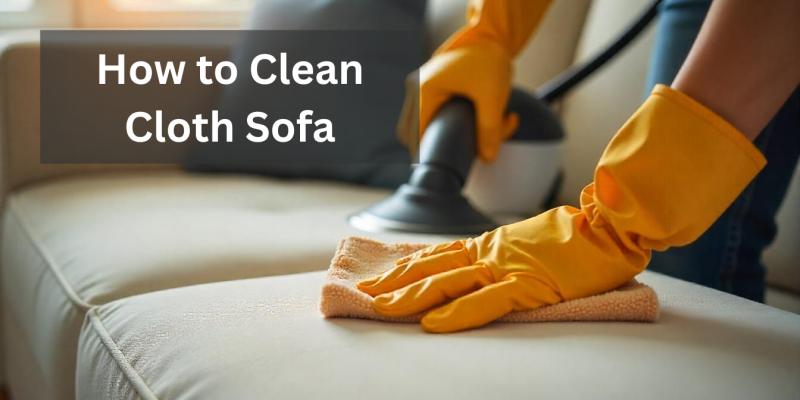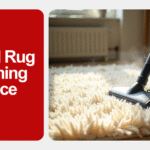Your fabric sofa is more than just furniture—it’s the centerpiece of your living space where family memories are made and guests are entertained. In the UAE’s unique climate, particularly in Dubai, Sharjah, and Ajman, maintaining clean upholstery is essential due to dust, humidity, and daily wear. Proper sofa cleaning Dubai services or techniques can help you clean your cloth sofa effectively, extend its lifespan, and ensure a healthy living environment for your family.
Why Clean Fabric Sofas Matter in UAE’s Climate
Living in Dubai, Sharjah, or Ajman means dealing with fine desert dust that settles into every corner of your home, including your beloved sofa. The combination of air conditioning, humidity fluctuations, and outdoor particles creates unique challenges for fabric sofa maintenance. Regular sofa cleaning becomes essential not just for aesthetics, but for health reasons too.
Fabric sofas in the Ajman accumulate dust mites, allergens, and bacteria that can trigger respiratory issues and skin irritation. Repeated air con use also causes brittleness in the fabric fibers after sometime, making it all the more important to take proper care. Understanding how to clean cloth sofa effectively helps combat these regional challenges while preserving your furniture investment.
Understanding Your Fabric Sofa Type
Before diving into cleaning methods, it’s essential to identify your sofa fabric type. Different fabric sofas require different approaches, and using the wrong cleaning method can damage your upholstery permanently. Check your sofa’s cleaning code, usually found on a tag attached to the cushion or frame.
Common Cleaning Codes:
W: Water-based cleaners only
S: Solvent-based cleaners only
WS: Either water or solvent-based cleaners
X: Vacuum only, no liquid cleaners
Natural fabric sofas like cotton and linen are generally easier to clean than synthetic blends, but they may shrink or fade if not handled properly. Microfiber and polyester fabric sofas are typically more stain-resistant but can attract static and pet hair. Understanding your specific fabric couch type is the first step in learning how to clean cloth sofa effectively.
Essential Tools and Supplies for Sofa Cleaning
Having the right tools makes all the difference when you clean fabric sofas. Here’s what you’ll need for effective home cleaning:
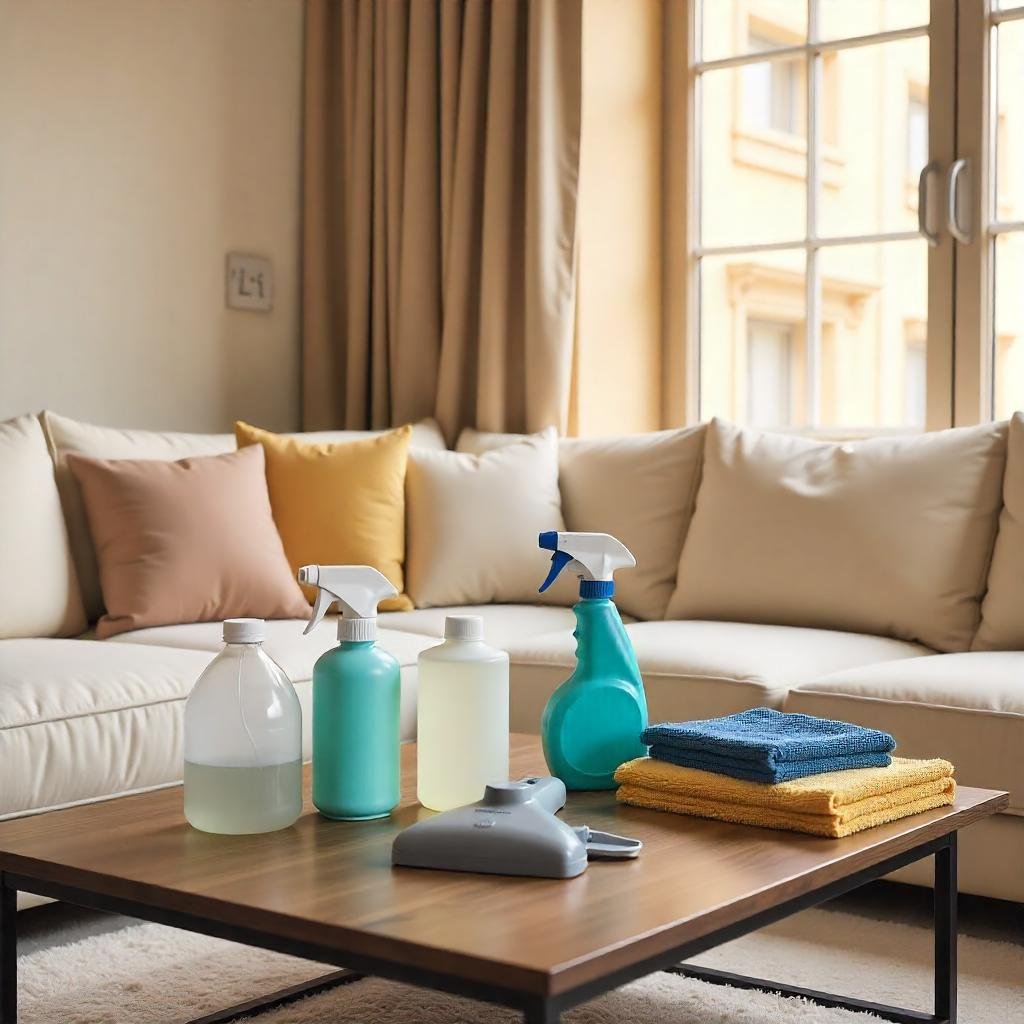
Basic Cleaning Kit:
Vacuum cleaner with upholstery attachment
Micro fiber cloth (different packs)
Clean cloth for blotting
Dry cloth to dry with
Spray bottles for cleaning solutions
Soft-bristled brush
Baking soda for odor removal
Cleaning Solutions:
Mild dish soap mixed with warm water
White vinegar solution for stubborn stains
Commercial upholstery cleaner (fabric-appropriate)
Steam cleaner for deep clean sessions
The key to successful DIY sofa cleaning lies in preparation. Always test any cleaning solution on a hidden area first before applying it to visible parts of your sofa. This simple step can prevent costly damage and ensure your cleaning process goes smoothly.
Step-by-Step Guide to Clean Your Fabric Sofa
Step 1: Formation/ Early Staging
Begin cleaning by removing all cushions and thoroughly inspecting your sofa for stains, wear patterns, and areas needing special attention. This is when you’ll determine the best cleaning method for your specific situation. Take photos of any existing stains to track your progress.
Remove loose items like coins, toys, or debris from crevices. Check each cushion individually, as they may have different levels of soiling. This initial assessment helps you plan your cleaning approach and ensures you don’t miss any problem areas.
Step 2: Vacuum the Sofa Thoroughly
Start with comprehensive vacuuming using your vacuum cleaner’s upholstery attachment. This step removes surface dust and debris, making subsequent cleaning more effective. Pay special attention to crevices where dust and debris accumulate.
Use the crevice tool to clean tight spaces between cushions, along seams, and around buttons or decorative elements. Don’t forget to vacuum the sofa cushions separately, including their undersides. For pet hair removal, use a lint roller or slightly damp rubber gloves to lift stubborn fur from fabric fibers.
Vacuum the entire sofa systematically, working from top to bottom. This prevents dust from settling on already-cleaned areas. The thorough vacuuming process is crucial for effective sofa cleaning and sets the foundation for deeper cleaning steps.
Step 3: Treat Stains and Spots
Address stains immediately after vacuuming. The key to successful stain removal is acting quickly and using the right technique. Always blot stains rather than rubbing them, as rubbing can push the stain deeper into fabric fibers and spread it to surrounding areas.
For fresh spills, use a clean cloth to absorb as much liquid as possible. For older stains on your sofa, create a cleaning solution appropriate for your fabric type. Mix mild dish soap with warm water for most fabric sofas, or use a commercial upholstery cleaner following manufacturer instructions.
Apply the cleaner to a clean cloth rather than directly to the sofa fabric. Gently blot the stain from the outside edges toward the center to prevent spreading. After treating the stain, use another damp cloth to remove soap residue, then dry the area with a clean, dry cloth.
Step 4: Deep Clean the Entire Sofa
Once spot cleaning is complete, it’s time for overall deep cleaning. This step ensures your entire sofa receives consistent treatment and removes embedded dirt that regular vacuuming can’t reach.
For water-safe fabrics, lightly mist the sofa with your cleaning solution, working in small sections. Use a microfiber cloth to gently agitate the fabric, allowing the cleaner to penetrate the fabric without oversaturating it. This approach assists it to eliminate ground in dirt and revitalise the overall exterior.
If you have access to a steam cleaner, use it according to manufacturer instructions for your fabric type. Steam cleaning can effectively sanitize your sofa while removing deep-seated dirt and allergens. Nevertheless, make sure that your fabric can take moisture and leave time to dry.
Step 5 Rinse and Dry
After cleaning, remove all soap residue by going over the sofa with a clean, damp cloth. This is an important step as any soap left behind may create re-soiling due to encouragement of soil. Work systematically to ensure no cleaning product remains on the fabric.
Allow your sofa to air dry completely before replacing cushions or using the furniture. Proper drying also prevents growth of molds and mildew, which may be a challenge in some climatic situations, such as the one enjoyed in Dubai where the climate is humid. The drying process can be enhanced by opening windows or by use of fans to increase air flow.
Advanced Cleaning Techniques
Steam Clean for Deep Sanitization
For thorough cleaning, consider using a steam cleaner designed for upholstery. Steam cleaning penetrates deep into fabric fibers, killing bacteria and dust mites while removing embedded dirt. This method is particularly effective for fabric sofas in Dubai’s dusty environment.
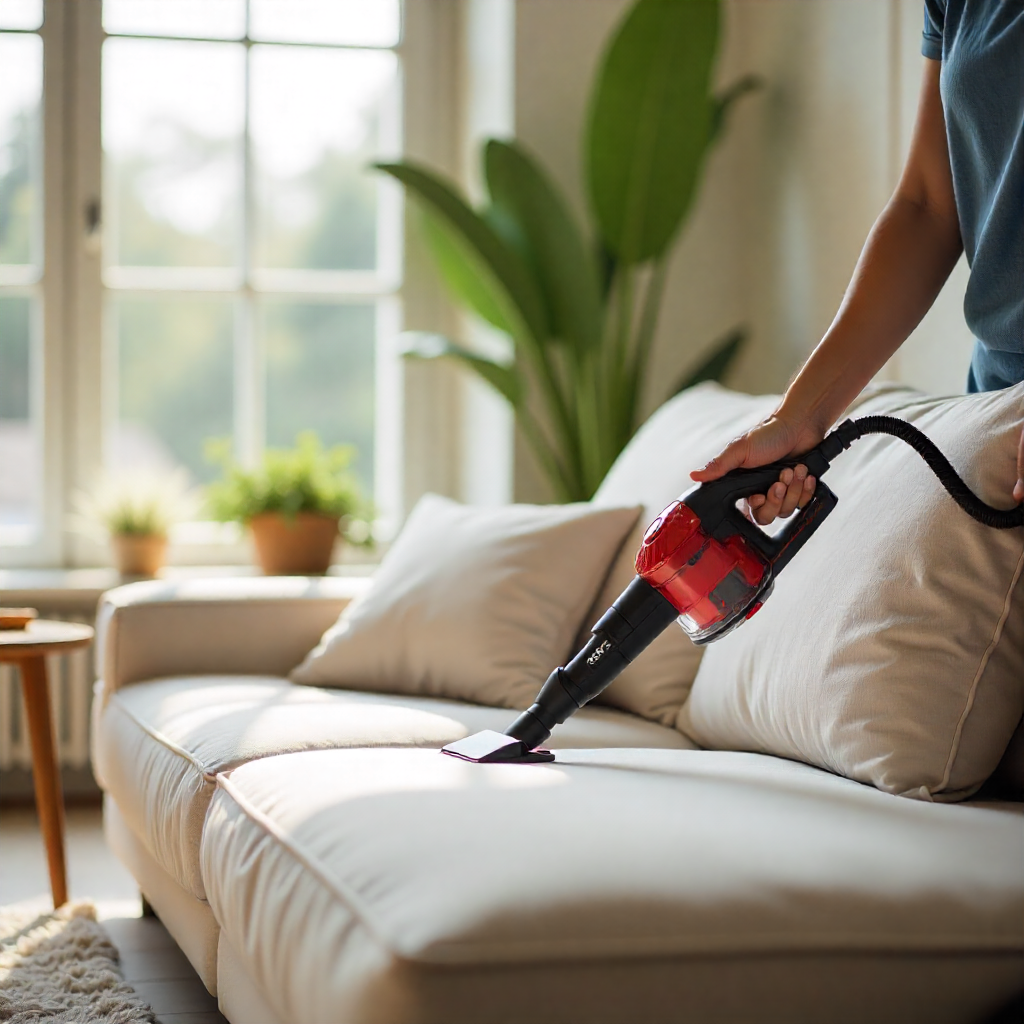
When you use a steam cleaner, work in overlapping passes to ensure even coverage. The extreme heat of the steam sanitizes without use of harsh cleansing chemicals, making it safe in households with children and pets. Allow the sofa to dry completely after steam cleaning.
Baking Soda Treatment for Odor Removal
Baking soda is excellent for removing odors from fabric sofas. Sprinkle baking soda evenly across the entire sofa surface and let the baking soda sit for at least 15 minutes, or overnight for strong odors. The baking soda will absorb unpleasant smells and moisture.
After the waiting period, vacuum the entire sofa again to remove all baking soda residue. This natural deodorizing method is safe for all fabric types and particularly effective for pet odors or cooking smells that can penetrate upholstery fabric.
Professional-Grade Cleaning Methods
For stubborn stains or valuable furniture, consider professional cleaning techniques. Professional cleaners have access to specialized equipment and cleaning products not available to consumers. They can also assess your specific sofa fabric and recommend the most appropriate cleaning method. cause fabric fibers to become brittle, while humidity can promote mold growth if sofas aren’t properly dried after cleaning.
Professional upholstery cleaning services in Dubai, Sharjah, and Ajman use industrial-strength equipment that can extract more dirt and moisture than home cleaning methods. This thorough cleaning approach can significantly extend your sofa’s lifespan and maintain its appearance.
Maintenance Tips for Long-Lasting Fabric Sofas
Regular Cleaning Schedule
Establish a regular cleaning routine to keep your fabric sofas looking their best. Weekly vacuuming prevents dust accumulation and makes deep cleaning sessions more effective. Monthly spot cleaning addresses minor stains before they become permanent.
Schedule thorough cleaning every 6-12 months, depending on usage and household factors like pets or children. Homes in Dubai’s dusty environment may need more frequent cleaning to maintain optimal appearance and hygiene.
Protective Measures
Consider using sofa covers or throws to protect high-use areas from wear and stains. These protective coverings are easier to clean than the sofa itself and can significantly extend your furniture’s lifespan. Make sure you have intimate covers to match with your decoration and yet offer functionality.
Position your sofa away from direct sunlight to prevent fabric fading and deterioration. Dubai has a very hot sun and thereby UV protection is essential to keep the color and integrity of the fabric. Install curtains or blinds to help cut bright sunlight during the peak hours.
Immediate Spill Response
Train family members to respond quickly to spills. Keep a clean cloth easily accessible near seating areas for immediate blotting action. The faster you respond to spills, the less likely they are to become permanent stains on your sofa.
Create a simple spill response kit with clean cloths, mild cleaning solution, and paper towels. Having these supplies readily available ensures you can address accidents immediately, preventing minor incidents from becoming major cleaning challenges.
Some of the Common Mistakes You have to avoid
Excessive Moistening of Fabric
One of the most common mistakes when learning how to clean cloth sofa is using too much water or cleaning solution. Over-wetting may shrink the fabric, make it bleed color or grow mold. Always use minimum moisture, and follow drying.
Test water absorption in a hidden area before beginning full cleaning. Some fabrics are more water-sensitive than others, and understanding your sofa’s limitations prevents damage during the cleaning process.
Using Wrong Cleaning Products
Never use harsh chemicals, bleach, or inappropriate cleaning products on your fabric sofa. These may lead to permanent staining or damage to the fabric or be an health hazard. Always check cleaning codes and use appropriate cleaning products for your specific fabric type.
Avoid using carpet cleaner on upholstery unless specifically designed for both applications. Carpet cleaning products may be too harsh for delicate sofa fabrics and can cause unexpected damage.
Neglecting the need of Questioning the advice of a Professional
While DIY cleaning is effective for routine maintenance, some situations require professional intervention. Valuable antique sofas, extensive staining, or fabric damage should be handled by experienced upholstery cleaning professionals.
Don’t attempt to clean expensive or delicate fabrics without proper knowledge. Professional cleaners have the expertise and equipment to handle challenging cleaning situations safely and effectively.
When to Call Professional Cleaners
Signs That You Must Seek Professional Help
If your fabric sofa has extensive staining, persistent odors, or valuable fabric that requires special care, professional cleaning is the best choice. Professional cleaners can assess your specific situation and recommend the most appropriate treatment.
Large stains, water damage, or cleaning attempts that have made problems worse are clear indicators that professional intervention is needed. There is no need to court more problems with DIY endeavors when a professional should handle the case.
Benefits of Professional Cleaning
Professional upholstery cleaning services use specialized equipment and techniques that achieve better results than home cleaning methods. They can remove deep-seated dirt, allergens, and stains that regular cleaning cannot address.
Professional cleaning also includes proper drying techniques that prevent mold and mildew growth. This is quite essential especially in the sizzling environment in Dubai, where lack of drying can cause serious inconveniences.
Seasonal Cleaning Considerations for UAE Climate
Summer Cleaning Challenges
Dubai’s summer heat and humidity create unique challenges for fabric sofa maintenance. Increased air conditioning use can cause fabric fibers to become brittle, while humidity can promote mold growth if sofas aren’t properly dried after cleaning.
During summer months, ensure excellent ventilation when cleaning your sofa. Use of fans and dehumidifiers will accelerate drying in order to avoid moisture-related problems. Consider more frequent cleaning during this season due to increased indoor time and air conditioning use.
Winter Maintenance
Less humid winter conditions are compensated in the winter by increased amounts of dust brought up by seasonal winds. This is an excellent time for thorough cleaning and maintenance. The cooler, drier air makes it easier to dry cleaned sofas completely.
Use winter months for deep cleaning projects and protective treatments. The comfortable temperatures make it easier to work on extensive cleaning tasks without the discomfort of summer heat.
Eco-Friendly Cleaning Solutions
Natural Cleaning Alternatives
Many effective sofa cleaning solutions can be made from common household items. White vinegar mixed with water creates an excellent natural cleaner that removes stains and odors without harsh chemicals.
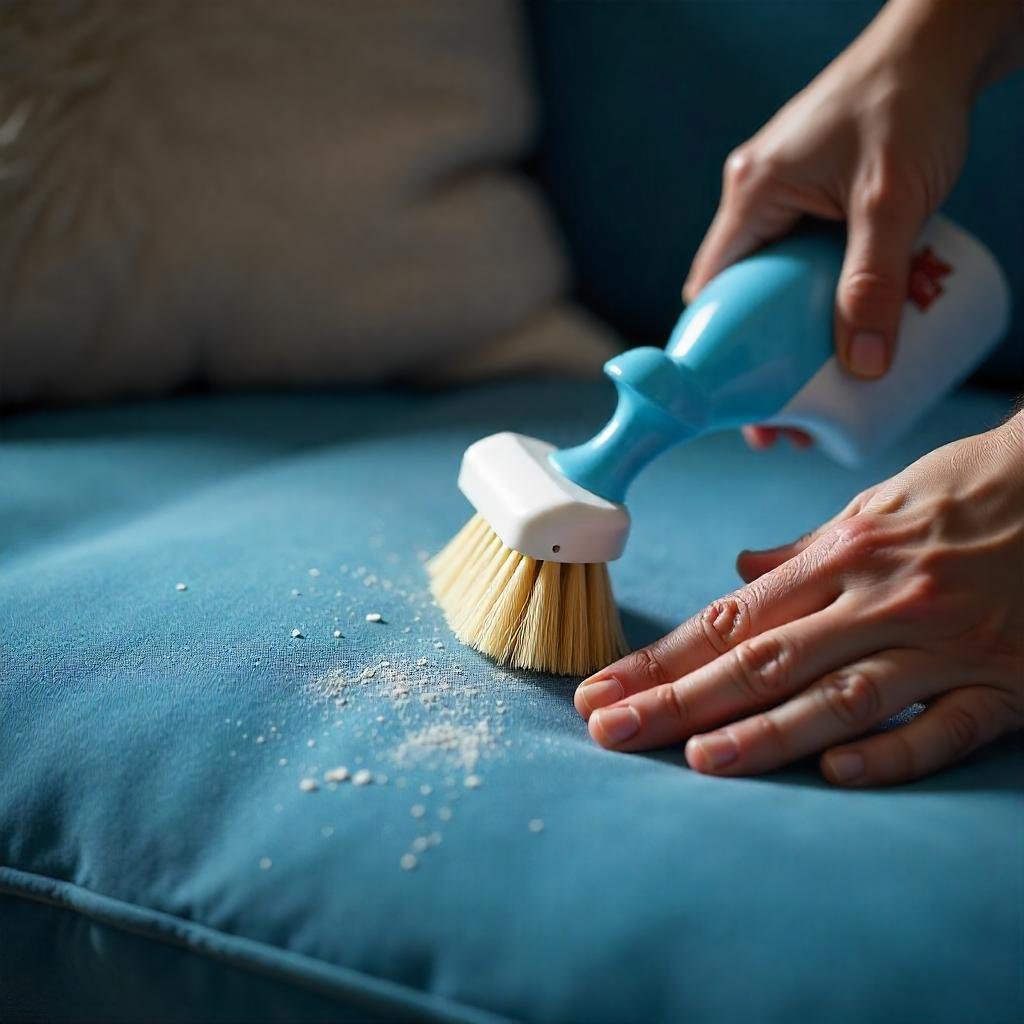
Baking soda is another versatile natural cleaner that absorbs odors and can help lift stains. The environmentally conscious alternatives are friendly to children and pets in families and are also safe to the environment.
Green Cleaning Benefits
Using natural cleaning products reduces chemical exposure in your home while being gentler on fabric fibers. These solutions are often more cost-effective than commercial cleaners and readily available in Dubai, Sharjah, and Ajman.
Green cleaning methods also reduce environmental impact, which is increasingly important in sustainable living practices. Many natural cleaners are biodegradable and don’t contribute to indoor air pollution.
Cost-Effective Cleaning Strategies
DIY vs. Professional Cleaning
Understanding when to clean your sofa yourself versus hiring professionals can save money while ensuring proper care. Routine maintenance and minor stain removal are perfect for DIY approaches, while major cleaning projects may require professional expertise.
Calculate the cost of cleaning supplies and your time investment against professional cleaning services. Sometimes professional cleaning is more cost-effective, especially for valuable furniture or challenging cleaning situations.
Budget-Friendly Cleaning Tips
Create your own cleaning solutions using household items like dish soap, white vinegar, and baking soda. These ingredients are inexpensive and effective for most cleaning tasks.
Invest in quality cleaning tools that will last for multiple cleaning sessions. A good vacuum cleaner with upholstery attachments and quality microfiber cloths are worthwhile investments for ongoing sofa maintenance.
Frequently Asked Questions
How Do You Clean a Fabric Sofa at Home?
To clean a fabric sofa at home, start by checking the cleaning code on your furniture tag. Begin with regular vacuuming using a vacuum cleaner with upholstery attachments to remove dust and debris. For spot cleaning, use appropriate cleaning solutions based on your sofa’s fabric type. The best way to clean involves working systematically from top to bottom, treating stains immediately, and allowing proper drying time. Remember that sofa at home cleaning requires patience and the right techniques to maintain your furniture’s appearance and longevity.
What’s the Best Method to Clean a Fabric Couch?
The most effective method to clean a fabric couch depends on your specific couch fabric type and cleaning code. Start by using a vacuum to remove surface dirt and pet hair from every part of the sofa. For water-safe fabrics, create a mild soap solution and gently blot stains rather than rubbing them. To clean a fabric couch properly, always test cleaning solutions on a hidden area first. For deeper cleaning, consider using an upholstery steam cleaner following manufacturer instructions, then ensure you dry the sofa completely to prevent mold and mildew.
How Often Should You Deep Clean Fabric Sofas?
You should deep clean fabric sofas every 6-12 months, depending on usage and household factors. High-traffic furniture or homes with pets and children may require more frequent deep cleaning. Regular maintenance includes weekly vacuuming and immediate spot cleaning of spills. To maintain a stain-free sofa, establish a consistent cleaning schedule that includes monthly inspections for wear and stains. Professional couch cleaning services can help with thorough deep cleaning when DIY methods aren’t sufficient for heavily soiled furniture.
Can You Use a Steam Cleaner on Fabric Upholstery?
Yes, you can use a steam cleaner on most fabric upholstery, but always check your cleaning code first. An upholstery steam cleaner is excellent for sanitizing and removing deep-seated dirt from sofa upholstery. Steam cleaning penetrates fabric fibers effectively, killing bacteria and dust mites while refreshing the material. However, ensure your couch fabric can handle moisture and allow adequate drying time after steam cleaning. Some delicate fabrics may not be suitable for steam cleaning, so always test in an inconspicuous area first.
What’s the Easiest Fabric Sofa to Clean?
Microfiber and synthetic blend fabrics are typically the easiest to clean compared to natural materials like cotton or linen. These materials resist stains better and can often be cleaned with water-based solutions. Unlike leather sofas, fabric options generally allow for more cleaning flexibility. The fabrics that are tightly woven are also easier to care over loose weaves. When shopping for new furniture, look for fabrics labeled as stain-resistant or performance fabrics, as these are designed to make fabric sofas look great with minimal maintenance effort.
How Do You Remove Stains from Your Fabric Sofa?
To remove a stain on your fabric sofa, act quickly by blotting (never rubbing) the spill with a clean cloth. Create a cleaning solution appropriate for your fabric type – mild dish soap mixed with water works for most materials. Apply the solution to a cloth rather than directly to the fabric, then gently work from the outside of the stain inward. Use water to remove soap residue, then blot dry with a clean towel. For stubborn stains, let it sit for a few minutes before blotting again, and consider professional cleaning for valuable or delicate fabrics.
Should You Use a Sofa Cover for Protection?
Using a sofa cover is an excellent way to protect your fabric furniture from daily wear, spills, and pet damage. Covers are much easier to clean than the actual upholstery and can significantly extend your sofa’s lifespan. Select covers that fit well and complement the decor and look at the same time, and also offer protection. Washable covers allow you to maintain a fresh appearance without the need for frequent professional cleaning. This protective measure helps you clean and care for your furniture more efficiently while preserving the original fabric underneath.
How Do You Vacuum Your Sofa Properly?
To vacuum your sofa effectively, use a vacuum cleaner with upholstery attachments and work systematically from top to bottom. Remove all cushions and vacuum each piece separately, including the undersides and crevices where debris accumulates. Use the crevice tool for tight spaces and seams, and don’t forget to vacuum the entire couch frame and base. For pet hair removal, use a lint roller or slightly damp rubber gloves before vacuuming. Regular vacuuming prevents dirt from embedding deep into fabric fibers and makes subsequent cleaning more effective.
What Cleaning Code Should You Look for on Fabric Couches?
The cleaning code tells you the safest way to clean your fabric couch and is usually found on a tag attached to the cushion or frame. “W” means the fabric can be cleaned with water-based solutions, “S” indicates solvent-based cleaners only, “WS” allows either water or solvent cleaners, and “X” means vacuum only with no liquid cleaners. Understanding your cleaning code prevents damage and helps you know how to clean your specific couch fabric safely. Never forget these tips so as not to make your warranties invalid and cause irreversible damages in your furnishings.
How Do You Freshen Up Your Couch Between Deep Cleanings?
To freshen up your couch between thorough cleanings, sprinkle baking soda all over the sofa and let it sit for 15-30 minutes to absorb odors, then vacuum thoroughly. Regular vacuuming removes surface dust and prevents dirt buildup. Rotate and flip cushions regularly to ensure even wear. Address spills immediately to prevent stains from setting. Use fabric refresher sprays designed for upholstery, or create a natural solution with water and a small amount of white vinegar. These simple maintenance steps help maintain a clean appearance and extend the time between professional couch cleaning sessions.
Conclusion: Maintaining Beautiful Fabric Sofas in the UAE
Learning how to clean cloth sofa properly is essential for maintaining beautiful, healthy living spaces in Dubai, Sharjah, and Ajman. The unique climate challenges of the UAE require consistent attention to fabric sofa care, but with the right knowledge and techniques, you can keep your furniture looking and feeling fresh for years to come.
Regular maintenance, prompt stain treatment, and appropriate cleaning methods will preserve your investment while ensuring a comfortable, hygienic home environment. Remember that how to clean cloth sofa effectively involves understanding your specific fabric type, using appropriate tools and techniques, and knowing when to seek professional help.
Whether you choose DIY cleaning methods or professional services, consistent care is key to maintaining fabric sofas that look great and provide comfortable seating for your family and guests. The effort you invest in proper sofa cleaning will pay dividends in extended furniture life, improved indoor air quality, and a more attractive living space.
By following these comprehensive guidelines for how to clean cloth sofa, you’ll be well-equipped to handle the unique challenges of maintaining fabric furniture in the UAE’s climate. Your sofa will remain a beautiful, comfortable centerpiece of your home for years to come.
Ready to Transform Your Sofa? Call AMPC Now!
Don’t let stubborn stains and embedded dirt compromise your comfort and home’s appearance. At AMPC, we specialize in professional sofa and carpet cleaning services throughout Dubai, Sharjah, and Ajman. Our expert team uses advanced cleaning techniques and eco-friendly solutions to restore your fabric sofas to their original beauty.
Why Choose AMPC for Your Sofa Cleaning Needs?
- Expert Knowledge: Our trained professionals understand how to clean cloth sofa of all types safely and effectively
- Advanced Equipment: We use professional-grade cleaning machines that deliver superior results
- Green Solutions: Non-Harmful to the family, pets and even the environment
- Safe and Convenient: Our technicians visit you at your residence in Dubai, Sharjah or Ajman at your time
- Satisfaction Guaranteed: We guarantee the satisfaction of our customers in what we do.
Contact AMPC Now
Address: England Cluster X-09, Office # 316, International City, Dubai, UAE
Phone: ( (+971) 55-661-0234
Email: info@sofaandcarpetcleaning.com
Transform your living space with professional sofa cleaning services that deliver exceptional results. Call AMPC now to schedule your appointment and experience the difference professional cleaning makes. Your sofa deserves the best care – let us help you maintain a beautiful, healthy home environment throughout the UAE.
Book your professional sofa cleaning service today and enjoy fresh, clean furniture that looks and feels like new!


